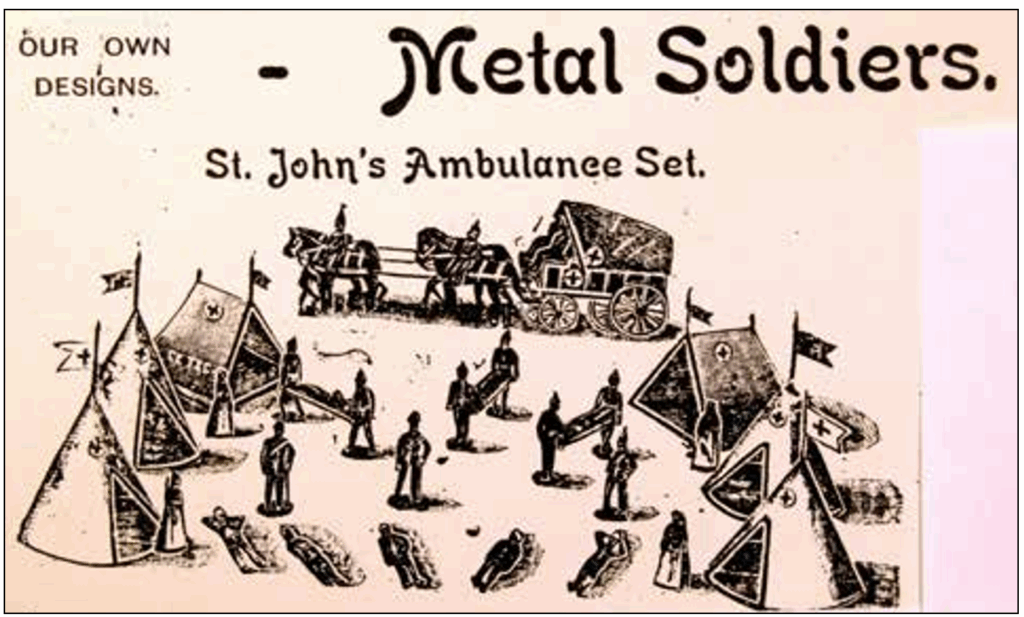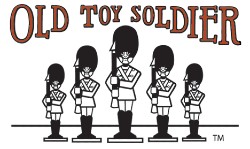Introduction
Britains Ltd. of London may be the most famous toy soldier manufacturer in history, starting to produce their hollowcast military figures in 1893. Today 131 years later, production of toy soldiers continues by W Britain, now based in Ohio. While the initial production focused on British Regimental foot and cavalry in full Victorian uniforms, it was not until 1905 that Britains expanded their production into support services. This included set #137, a large set of Royal Army Medical Corps, and a year later the introduction of the horse-drawn ambulance (#145).
The inspiration for these probably came as they realized their German competition was producing all sorts of equipment and medical figures to supplement what every good army required. It may also have come from customers who wanted a more complete British Army in miniature as the technology and equipment of the contemporary British Army developed and expanded. Regardless, production of Royal Army Medical Corps (RAMC) sets continued in the metal catalog up until 1941 (when production of toys ceased in order to devote resources to the war effort). In the late 1930s a number of new sets and figures were introduced, representing a change from Victorian-era full dress review order to the khaki service full battle dress of the new British Army as they prepared for eventual war with the German Axis.
In the post-WW II catalog the number of RAMC sets was greatly diminished, though some representation of medical sets lasted until 1961. Interestingly, all the various sets employed much the same figures; doctor, nurse, stretcher team and casualty, with the only major changes to wartime khaki/OD and motorized ambulances. This article provides an annotated summary, through progressive set numbers, of all the Britains Ltd medical sets produced in metal between 1905 and 1961. Please note that most of the hard work in defining each set has been done through the dedicated efforts of collectors/authors Joe Wallis, James Opie and others cited in the bibliography. Without their research none of this article could have been completed.
A brief history of the Royal Army Medical Corps (RAMC)
This historical summary was in part derived from a more complete Wikipedia history of the RAMC (see reference #5). The beginning of professional medical services as an official branch of the British armed services dates from just after the Restoration of Charles II in 1660. For the next two hundred years, medical services were arranged on a regimental basis, with each battalion responsible for its own medical staff and facilities. Oversight was provided by an appointed Surgeon-general, a Physician-general and an Apothecary-general. In 1793 an Army Medical Board was formed to establish greater oversight and to implement current civilian healthcare practices. However, the military hierarchy seemed to have little time for developing and funding some ancillary services, and the history of military medicine in the British armed services up until before the first world war is a litany of failure and obstruction, costing thousands of British lives.
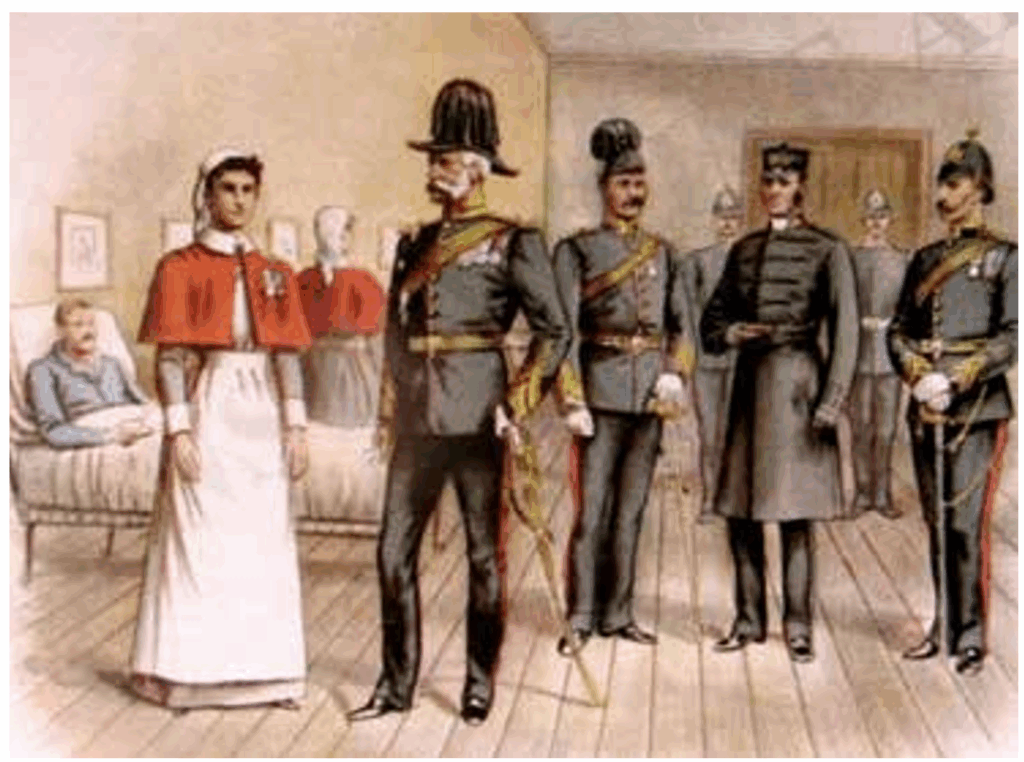

The implementation of the army Medical Board resulted in establishing several (non-regimental) military hospitals. This experiment only lasted until 1807 due to a disconnect between the regimental model, mismanagement, and poor outcomes. In 1810, the Army Medical Board model was abolished and a new Army Medical Department was established, directed by a board chaired by Director-General James McGrigor. He had been the principal medical officer under the Duke of Wellington during the Peninsular War, where he had introduced significant and more efficient organizational changes in the army’s medical services to try and save soldiers’ lives. Much like Napoleon’s Baron Larrey, he developed dedicated ambulance wagons to get the wounded off the battlef ield and prefabricated transportable temporary hospitals for triage of the wounded. McGrigor served in the capacity of Director-General for 36 years and is considered the “Father of British Army Medicine”.
By 1854 with the onset of the Crimean War, the deficiencies and lack of priorities toward an understaffed and underequipped Army Medical corps became glaringly obvious. Within weeks of arriving in the Crimea, more than half the British force had been incapacitated by disease (mainly typhus, dysentery and cholera). Within seven months some 10,000 British servicemen, out of a total of 28,000, had died from disease. A primary hospital set up for the wounded, several hundred miles from the front, was built over an active sewer. Army physicians seemed resistant to, and threatened by current medical practices. It was only the work of a well-trained independent nursing corps, headed by the stubborn and well-connected aristocrat Florence Nightengale, as well as her unfiltered reports back to the British press, that finally jolted the Army into revamping their medical priorities. In 1855 a Medical Staff Corps was established to provide orderlies and stretcher bearers and officers. This later became part of the Army Service Corps.
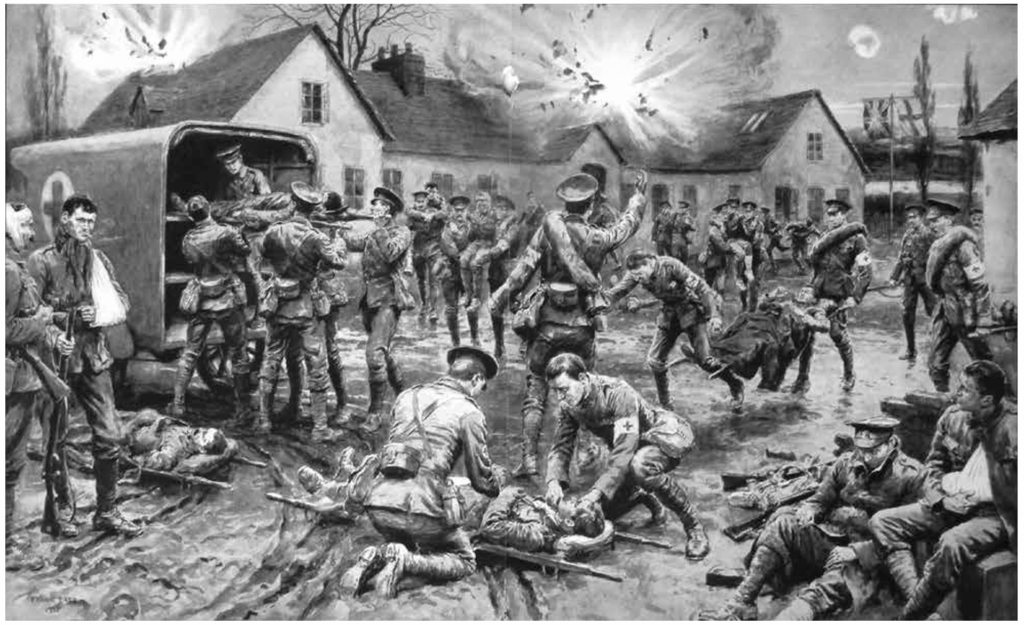
After severe criticism of the Crimean ineptitude, in 1857 a Royal Commission had been appointed for the improvement of sanitary conditions in Army barracks and hospitals. However, the regimental-based model of military medical support remained intact until 1873, and therefore the service was often inconsistent and understaffed. At this time a more rigorous and well-defined set of medical standards for army physicians, including their training and qualifications, was established. In 1884, the medical officers of the Army Medical Department were unified to form the Army Medical Staff, and given command of the Medical Staff Corps, consisting of non-physician medical ranks. However, the Army did not provide official military ranks for the physicians, nor military pensions for service, and they were woefully underpaid. This understandably led to an inability to recruit physicians, despite having their own medical school. It was not until the issuing of a royal warrant in 1898, that officers and soldiers providing medical services were incorporated into a new body known by its name, the Royal Army Medical Corps (RAMC). Its first Colonel-in-Chief was Prince Arthur, Duke of Connaught.
The RAMC began to develop during the Boer War of 1899-1902. In this conflict the RAMC lost 743 officers and 6,130 of its Corps soldiers.
However, far more of them, and thousands more of the sick and wounded whom they treated, would have died if it had not been for the volunteer civilian doctors working in South Africa. Again, the British military physicians, support staff and hospitals proved totally inadequate compared to the parallel civilian medical volunteers, and again the resistance of the military hierarchy to fund and support the medical corps was the primary barrier. The most influential civilian was Alfred Fripp, who had established and organized a successful civilian hospital which only illustrated by comparison the chaos and inadequacies of the Army hospitals. Fripp’s concern for limiting unnecessary suffering was bolstered by his established friendship with the new King, Edward VII. Fripp showed him his plans for reform and the King made sure that Fripp’s plans for total reformation of the RAMC and its hospitals were not shelved by his government.
By 1917 and the Great War, the RAMC finally developed its potential in both size and experience out of necessity. The senior RAMC officers in charge finally (if grudgingly) adopted all Fripp’s surprising innovations. They established a network of military hospitals around the United Kingdom as well as hospitals in countries where there were British troops. It had taken the British Army only 257 years (and thousands of British lives) to bring their medical service up to speed with contemporary civilian medical standards. These improvements and the lessons learned from the carnage of the First World War served the RAMC well in the Second World War.
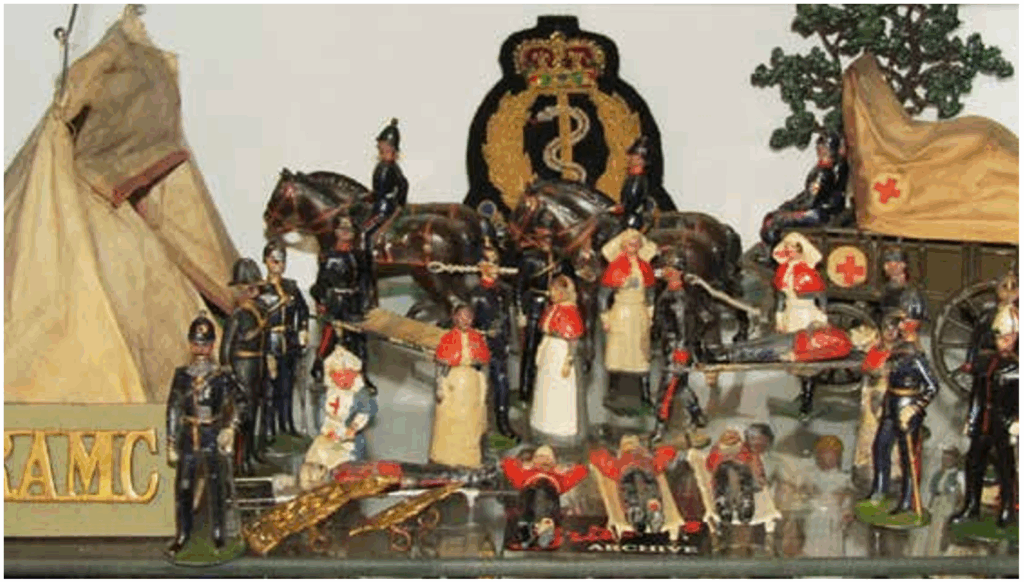

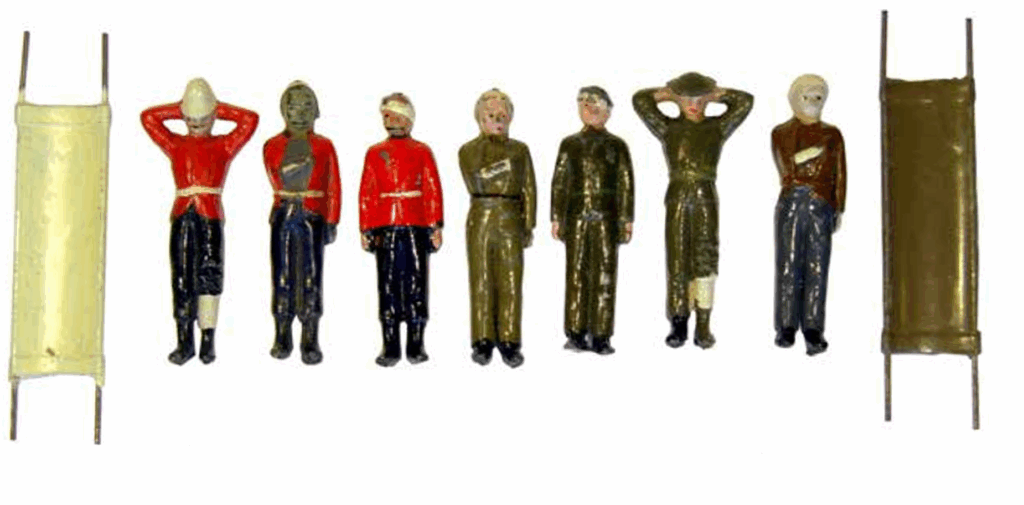
In October of 2024, the Secretary of State for Defence John Healey announced that it would amalgamate the RAMC with the Royal Army Dental Corps and Queen Alexandra’s Royal Army Nursing Corps to form one unified corps, the Royal Army Medical Service (RAMS).
A categorical and annotated listing of Britains sets containing the Royal Army Medical Corps or other medical-themed figures and vehicles
131: This was a huge 275-piece presentation set. It included a vast selection of British infantry, cavalry and even the rare British Camel Corps, but its original issue in 1906 did not include any examples of the RAMC. The set was updated in 1909 and now included pieces from set #145, the horse-drawn ambulance, as well as figures from set #137, Doctors and Nurses of the RAMC. This exceedingly rare set (due to its high price and limited availability) lasted in the catalog with its RAMC components until 1932.
132: This set was a second, but not quite as large (167 piece), presentation set of the “Types of the British Army”. It was introduced in 1906. However, its first permutation did not include any RAMC figures until the set was revamped in 1909 to include (among other things) the horse-drawn Ambulance from set #145. The revised set lasted until 1932.
137: The Army Medical Service was a large 24-piece set introduced in 1905. Joe Wallis notes that these figures were most likely based on Simkin print #111, RAMC, in the March 1897 issue of “The Army and Navy Gazette”. The officers and nurse from this print are dead ringers for the Britains figures. The contents included: 3 medical officers in full dark-blue review dress, including two physicians in ball helmets and a senior medical officer in a cocked hat; six walking stretcher bearers (also in blue uniforms with ball helmets); 3 white canvas stretchers; four standing nurses; and eight wounded casualties in prone positions. The medical officers always had a round base, the stretcher bearers were initially on oval bases until 1910. They changed from half-booted to full trousers in 1935. The first nurses were short and wore full length grey Victorian dresses with a white apron (often referred to as wasp-waisted) and no base. A taller nurse on a base was introduced to RAMC sets in 1936. The casualties in red tunics included bare-headed with bandaged heads or arms and another figure in a white foreign service helmet with his hands behind his head (this figure was replaced in 1935).

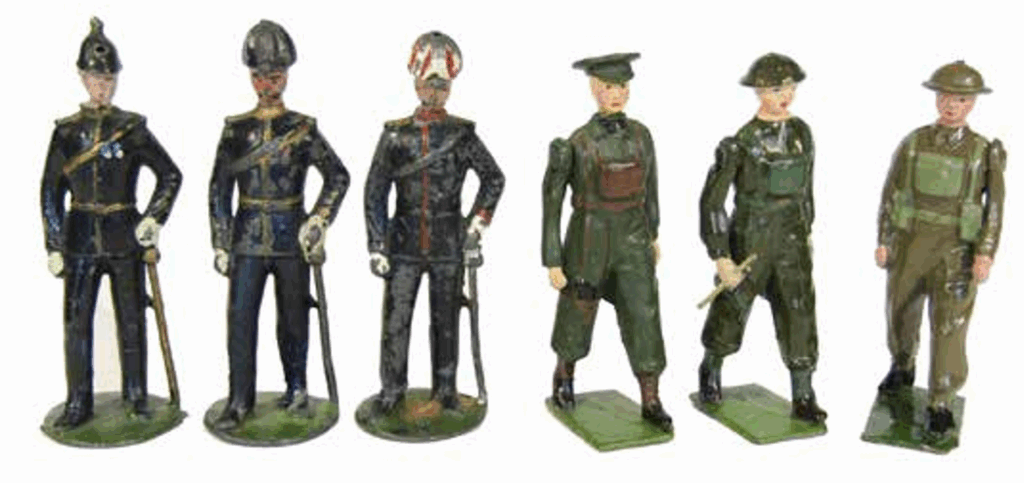
145: The Royal Army Medical Corps (with horse-drawn ambulance) was introduced in 1906. Four horses pulled the cloth covered wagon, using twisted wire tracings until 1916, which were then replaced by straight wire. Horses were equipped with collar harnesses until 1922, when they were replaced with the breast-harness tack. The wagon cover was tan cloth fabric, higher in the front, supported by metal wire supports. On the sides of the cover and the wagon, white paper roundels with red crosses were glued on. The personnel in review order included two mounted drivers in dark blue uniforms from the Royal Army Service Corps with ball helmets, a double white stripe on their pants and no red cross armbands. The seated orderlies also had blue uniforms, ball helmets, but a single stripe on the pants and a red cross arm band on the left upper arm. The set lasted until 1941, and was revived post-war in 1954 with the same catalog number. The new ambulance was painted grey, had larger rear wheels, and the horses were fitted with “H-shaped” wire traces that plugged into holes in the horses’ flanks. The cloth cover was now white and the rondels on the sides of the cloth wagon cover featured a red circle with a white cross rather than the prewar red cross. Post war set #145 lasted until 1959. It never appeared in the later 9000-series sets.
145A: The Royal Army Medical Corps, Active Service Order (with horse-drawn ambulance) was introduced in 1916. It differed from set #145 in that the active service order meant the corpsmen and teamsters wore khaki uniforms and flat caps rather than the review order blue dress and ball helmets. Otherwise, the set was the same. In 1933, this set received a new catalog number, #1450. It lasted in the catalog until 1941 but did not reappear post war.

Wagon colors: Joe Wallis, in his Armies of the World book (1) gives an excellent description of the changes made by Britains with their horsedrawn wagons. The wagons were painted grey until 1917 when Britains began their “fumed-metal” technique (giving it a “gun-metal” finish), and this lasted until 1931. The post 1931 painting was a dark green, and then a lighter khaki color until 1941. Post war, the wagon was painted grey.
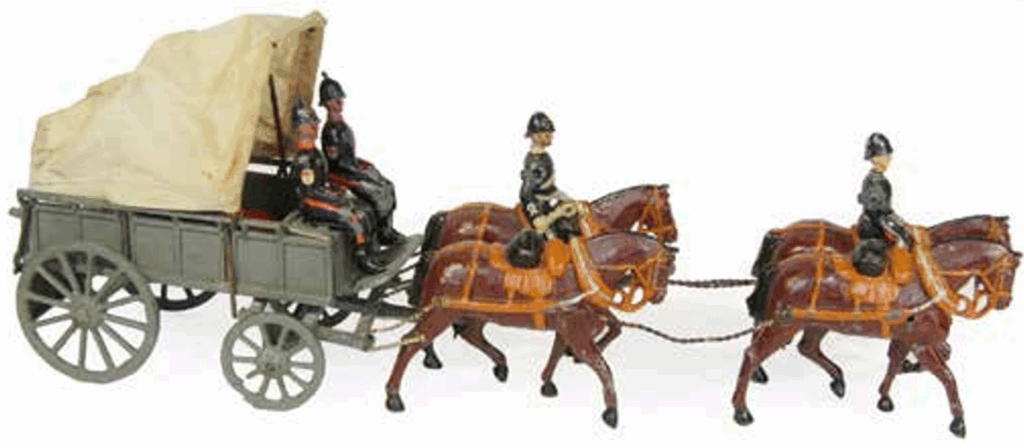
320: Royal Army Medical Corps Doctors and Nursing staff was a scaled-down 8-piece medical set. It was introduced in 1929, and included a senior physician in plumed bicorn, a physician in ball helmet (both on round bases) and 6 of the smaller 1st version nurses. In 1937 four of the nurses were replaced by 2 rectangular based stretcher bearers, a stretcher and a casualty with a bandaged head and arm. In 1938 the old Victorian nurse figures were replaced with the new taller nurse figure. The set lasted until 1941 and did not reappear in the post-war catalog
1232: Royal Army Medical Corps Nurses was an un-cataloged boxed set which included 8 of the first Victorian wasp-waisted version of nurses. It was available only in 1933, and no example of the set with the improved nurse figure was ever made.
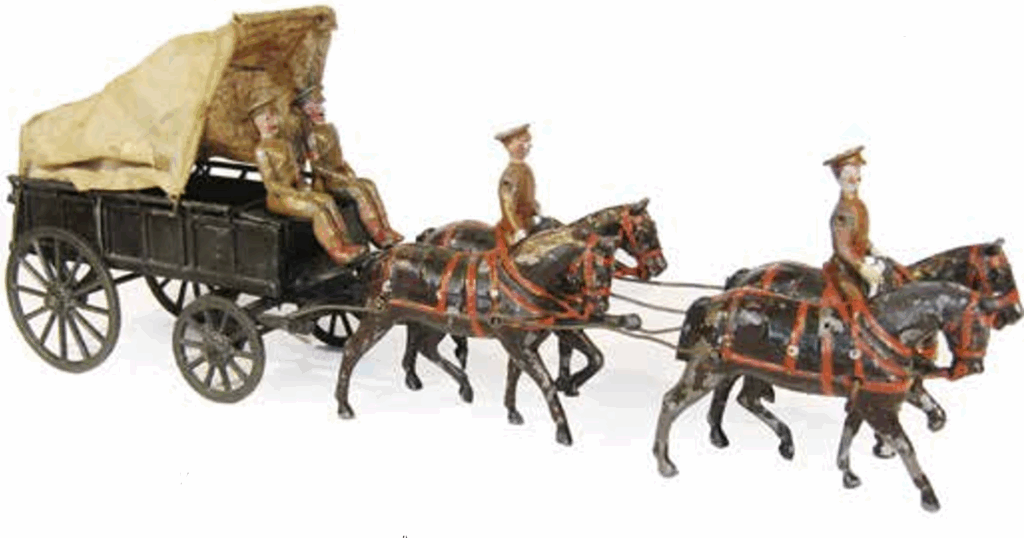
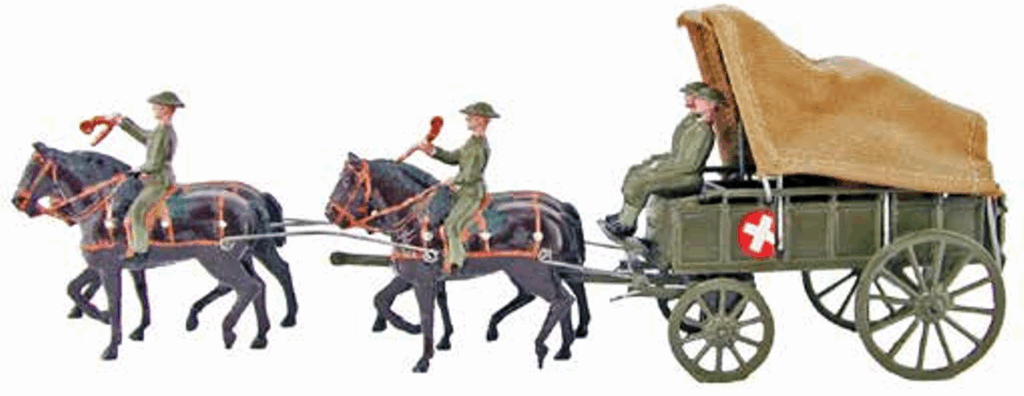
1300: Royal Army Medical Service with Wagons, Doctors, Nurses, Wounded and Hospital Marquee was initially released in 1934 as a large 41-piece presentation set. It included the horse-drawn ambulance (set #145), the General Service wagon (set #146), the 24 full-dressed medical figures from set #137 (see above), 2 elm trees (#523), 2 fir trees (#524) and a unique large Marquee Medical Tent (#0203). There were 3 nurses, the wasp-waist first version until 1937, after which the improved taller figure was inserted. There were 8 casualties; 3 with heads bandaged, 3 with their left leg bandaged and 2 with foreign service helmets tipped back. After 1936, the 2 casualties with foreign service helmets were replaced with bare-headed casualties with their arm in a sling. This set lasted until 1941 and did not reappear in the post-war catalog.
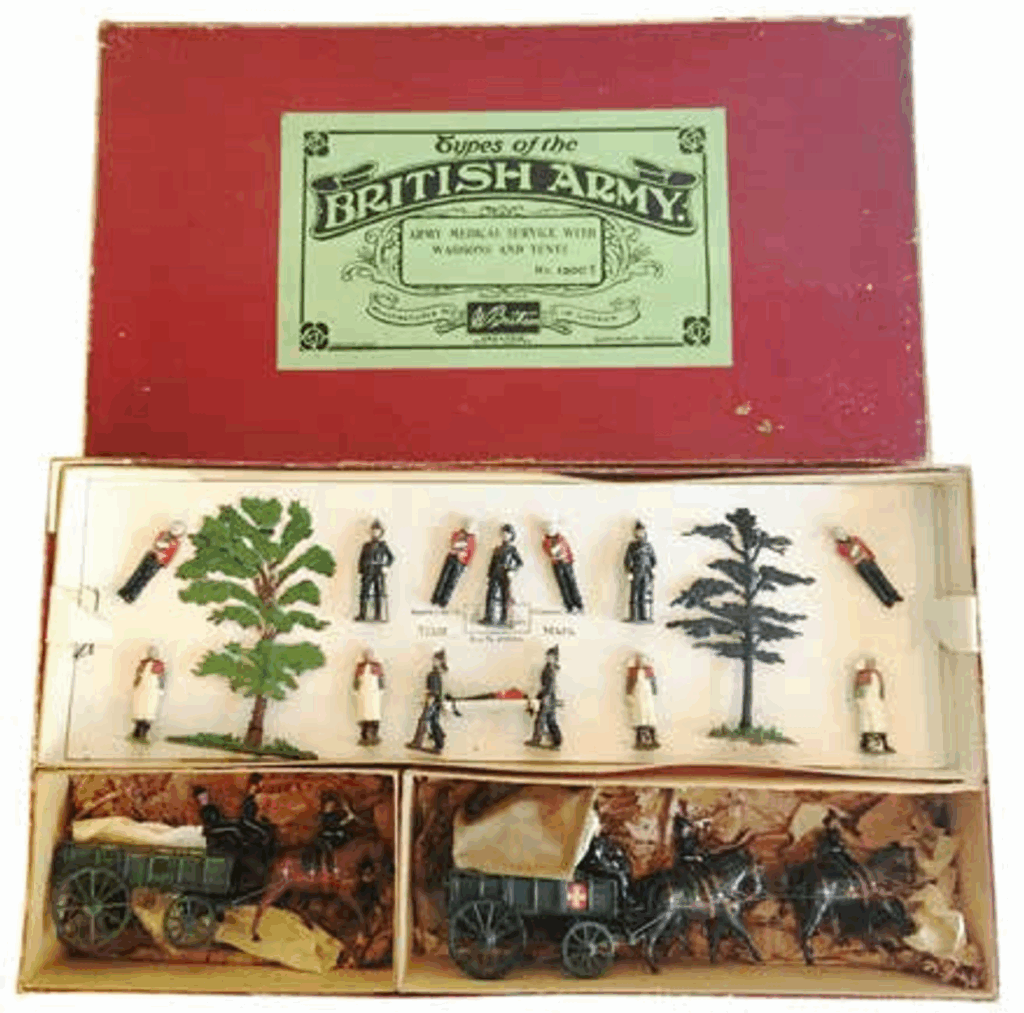
1372: This was an American version of the horse-drawn military ambulance. This unusual and rare set was not in the catalog but appeared in the late 1930s for the American market. It is similar to set #1450 except the khaki-clad corpsmen had peak caps with grey visors and wore grey belts. This set is exceedingly rare, and without an original box, collectors should consider that this may be an easy creative conversion.
1450: The Royal Army Medical Corps Ambulance Wagon; Active Service Order was renumbering of set #145A in 1933 (see above), It was given its new catalog distinction as the toy armies of Britains became more khaki-clad. In 1940, the figures in peaked caps were replaced by figures in steel helmets. This modernizing of the figures lasted only 1 year until 1941, and the steel-helmeted version of the ambulance wagon was never included in any other Britains medical set, making it unusually rare.


1457: This was a large display featuring the 3rd Hussars, 7th Fusiliers, Grenadier Guards and Royal Army Medical Corps. This was an un-cataloged 31-piece presentation set issued only in 1936. The RAMC f igures were from set #320, the Royal Army Medical Corps Doctors and Nursing staff (1st version nurses and without stretcher or causalities). However, it did contain an oblong cloth tent (#0202) which was smaller than the Marquee Medical Tent in set #1300.
1512: This featured the new Army Ambulance, Motor-Type, with Driver, wounded man and stretcher. This first version of a square radiator (“box-front”) olive/khaki ambulance was issued in 1937. It was then revised to a dark green color, then back to olive green. It had white rubber tires and a red roundel with a white cross on the sides of the vehicle. The driver was seated in khaki with a peaked cap. A casualty was included using the wounded head version dressed in khaki. This permutation lasted until 1941. The ambulance was reintroduced into the catalog as early as 1946 using the same square radiator vehicle but with black rubber tires. Then, in 1948, an updated rounded nose version of a Commer ambulance was introduced. On the side of the vehicle was a small red roundel with a white cross in it. This lasted until 1957 when it was changed to a larger white roundel with the (correct) red cross in it. Also, in 1957 the windshield was fitted with a center bar from the hood to the roof (“split-windshield”). The driver was also updated with a black beret rather than a flat cap and had movable arms that gripped the steering wheel. This final version lasted in the catalog until 1960.
1512: This featured the new Army Ambulance, Motor-Type, with Driver, wounded man and stretcher. This first version of a square radiator (“box-front”) olive/khaki ambulance was issued in 1937. It was then revised to a dark green color, then back to olive green. It had white rubber tires and a red roundel with a white cross on the sides of the vehicle. The driver was seated in khaki with a peaked cap. A casualty was included using the wounded head version dressed in khaki. This permutation lasted until 1941. The ambulance was reintroduced into the catalog as early as 1946 using the same square radiator vehicle but with black rubber tires. Then, in 1948, an updated rounded nose version of a Commer ambulance was introduced. On the side of the vehicle was a small red roundel with a white cross in it. This lasted until 1957 when it was changed to a larger white roundel with the (correct) red cross in it. Also, in 1957 the windshield was fitted with a center bar from the hood to the roof (“split-windshield”). The driver was also updated with a black beret rather than a flat cap and had movable arms that gripped the steering wheel. This final version lasted in the catalog until 1960.
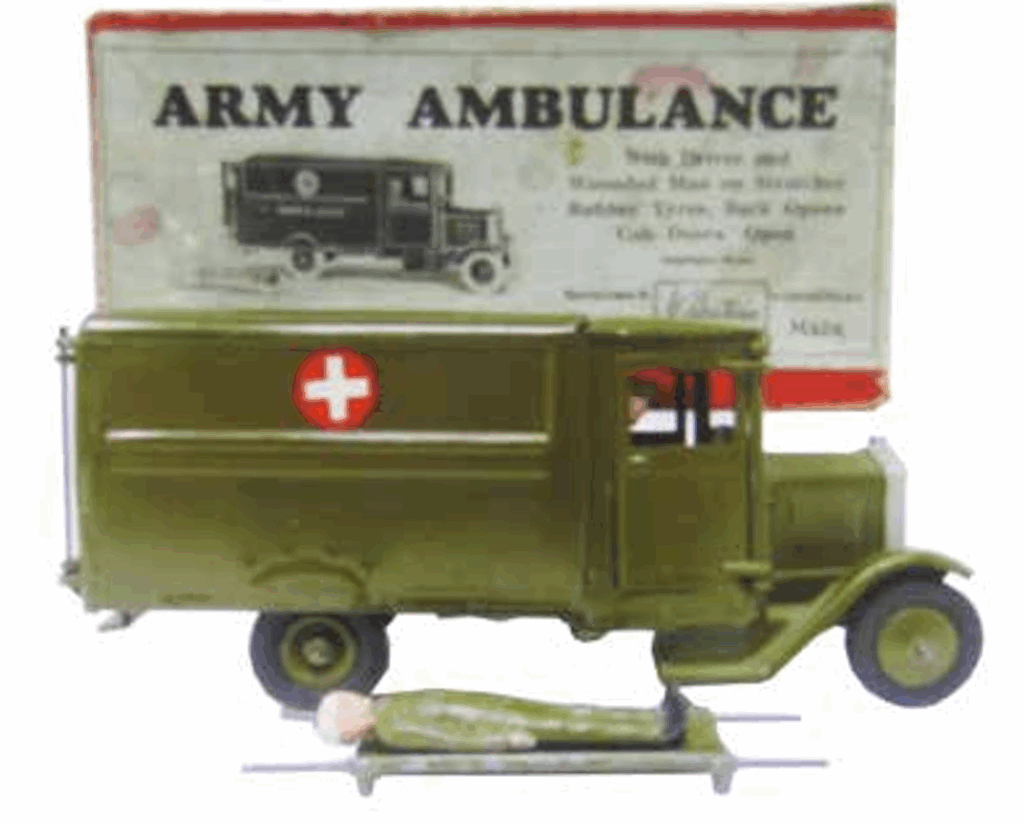
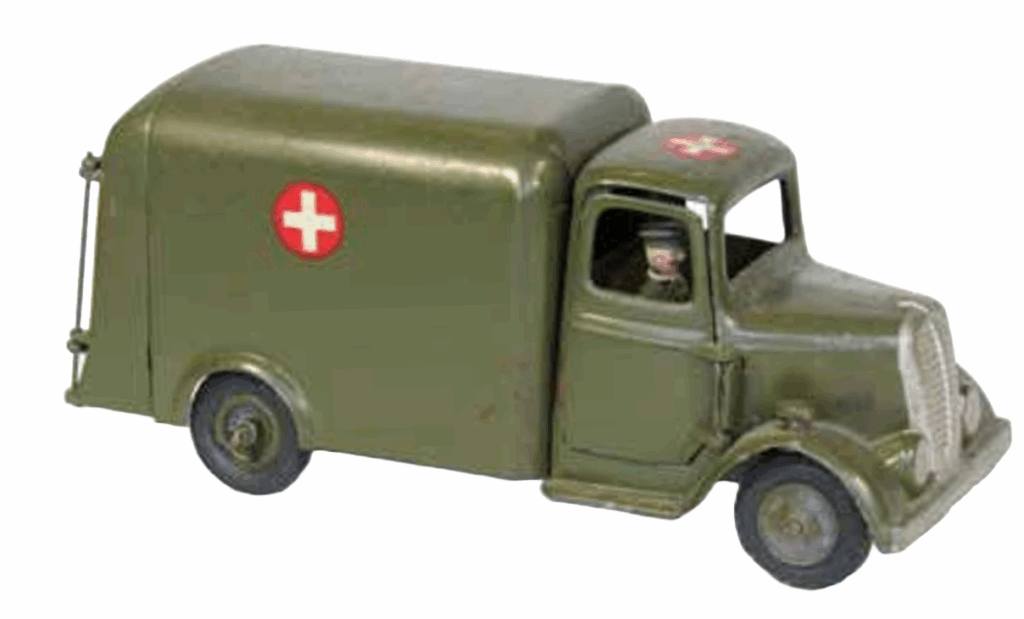
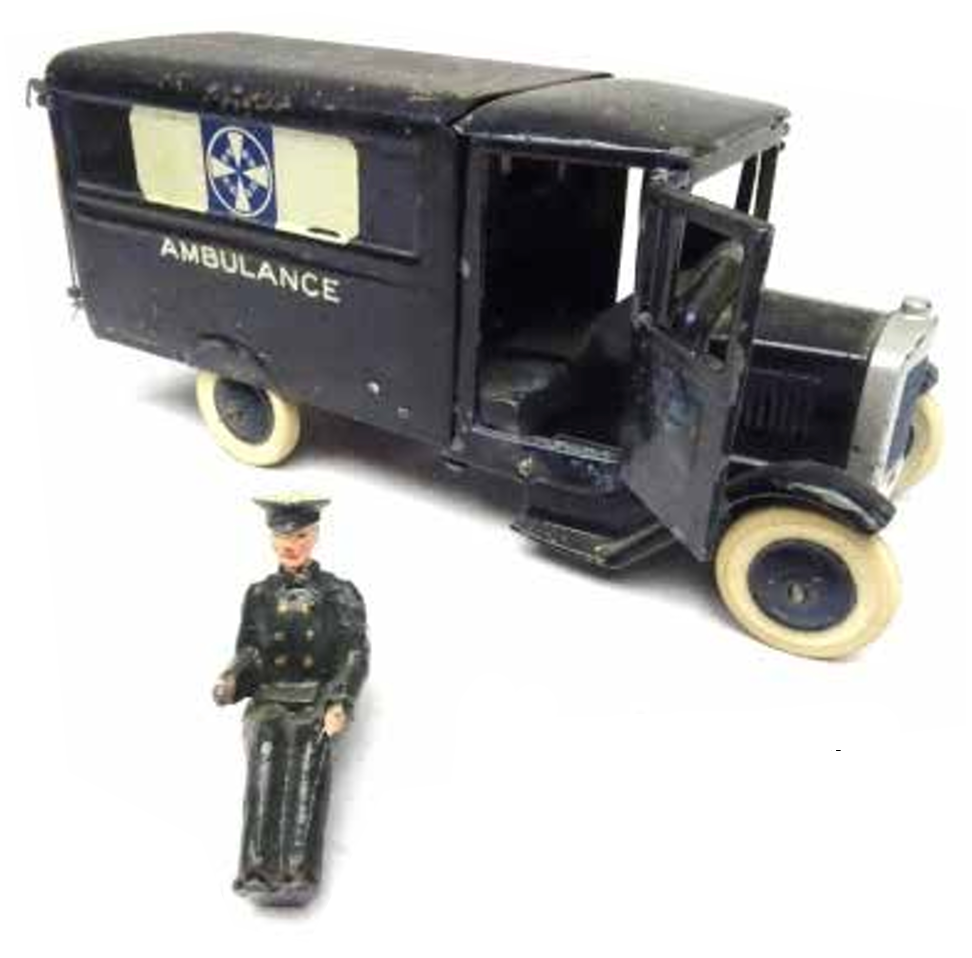
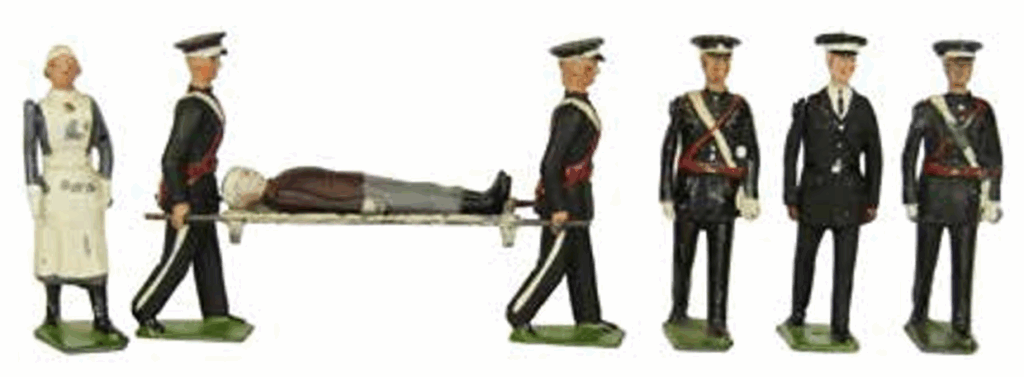
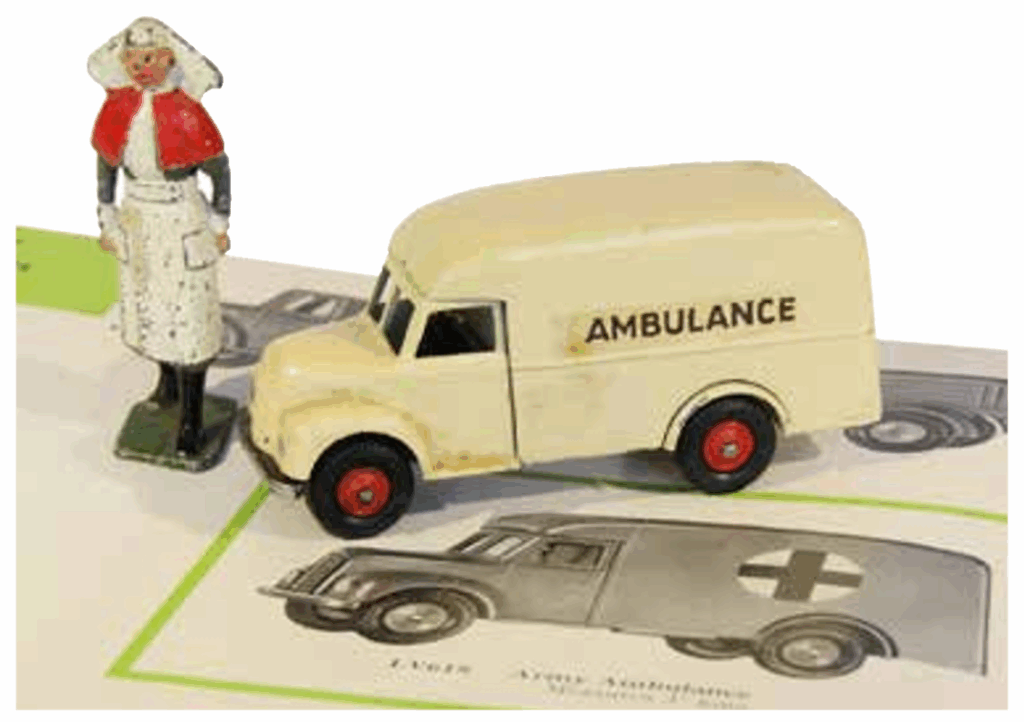
1514: The Corporation Type Motor Ambulance with Driver, wounded man and stretcher featured a vehicle which was a civilian variation of the pre-war #1512. It was issued in 1937. It used the first version square radiator vehicle with white rubber tires, but was painted in a cream-colored off-white, with a thin horizontal brown sign on the side with the word “AMBULANCE” on it in off-white. The bare-headed casualty wore a brown coat and grey pants, while the flat-cap driver was dressed in dark blue. This vehicle lasted in the catalog until 1941, but was never reintroduced in the post-war catalog.
1719. This was a Stretcher Party of the RAMC, in service dress with steel helmets. This half-set, introduced in 1939, was the first depiction of medical personnel of the modern (pre-WWII) army. It was a simple 4-piece set with two stretcher bearers in khaki service dress (no equipment other than cross belts, a canteen and haversack) but wearing the shrapnel-proof steel helmet of the modern British army. The stretcher was olive drab and the casualty was dressed in khaki, with a bandaged bare-head. This set lasted until 1941. It did not reappear in the post war catalog.
Note: While not described in factory records, this small set may have briefly appeared in khaki with flat caps rather than steel helmets, as those figures exist and chronologically this would be the most likely set to start with this head gear (see FIG 5).
1723. This set of Royal Army Medical Corps Unit, Containing Bearers, Stretchers, Wounded and Nurses was introduced in 1939 containing 9 pieces, using 2 pairs of stretcher bearers in service dress (as in #1719 above), olive-drab stretchers and only one casualty, dressed in khaki with a bandaged head. The set also included two of the new improved nurses in calf-length skirts. In 1940, the 4 stretcher bearers in service dress were replaced with the newly introduced version in “Battle Dress” now donning packs on the back and on the chest, gaiters, and steel helmets. The set lasted until 1941, and was re-released in the post-war catalog in 1946. The set lost one of its nurses in 1960, before leaving the catalog in 1961.
1759: The Air Raid Precautions Stretcher Party Squad and Gas Detection Services set was the only one of the three ARP sets which contained medical personnel. The set included 4 stretcher bearers in black rubber suits with olive headgear and gloves, two tan stretchers with half-booted bare-headed casualties with a bandaged head who wore brown jackets and grey pants. In addition, a fifth man in similar rubber suit equipped with a gas detection stick was included. These figures appeared only in this set and lasted 1939-1941.
1824. This was a large Presentation Box of British Service Units. The 48-piece set featured many of the new modern army equipment pieces (vehicles, guns, and spotting equipment) plus operators, drivers, and gunners, all dressed in khaki service dress. Included in this lot was a square radiator (box-front) Army Motor Ambulance, a khaki stretcher and khaki casualty with his arm in a sling to fit in the ambulance, plus 4 stretcher bearers in service dress, 2 khaki stretchers and a single casualty in khaki with a bandaged head, plus two of the 2nd version nurses. This set lasted until 1941, and did not reappear in the post-war catalog.
1869. The RAMC Casualty Clearing Station with Thatched Barn and Open Cart Shed. was an unusual medical set produced for Britains by Hugar. It included 2 wooden buildings on a 12 by 12-inch base. The barn was similar to Hugar civilian barns, but the added cart shed had a wooden roof with a large red square enclosing a white cross. No figures were included with this set (see set #1910 below). A full color picture of this unusual item can be found in Wallis’ “Armies of the World (2nd edition in color)” (2) on page 524.The set was available only in 1940-41 and did not reappear in the post war catalog.
1887. This set in the Historical Collectors Series, comprised 15 assorted single foot figures from the military line. It was not in the catalog but sold through the FAO Schwarz toy store in New York City. Within it were 2 stretcher bearers, a stretcher and casualty and a nurse. Since all the other figures were in review order dress, we can assume the medical figures were in their blue dress and ball helmets. This series was produced only in 1940-41.
1896. This set of Royal Army Medical Corps, Stretcher party, in steel helmets and battle dress was introduced in 1940 and comprised 8-pieces in full battle dress uniforms and steel helmets to complement Britains “New Army” sets. The set included a Battle Dress officer in steel helmet carrying a baton in his right hand, 2 battle dress stretcher bearers, one casualty with a bandaged head and arm on an olive stretcher, 2 empty handed orderlies and a female ambulance driver (but no ambulance!) walking (not sitting) in an olive uniform and skirt with brown belt and gloves. No nurses were included in this set. It lasted until 1941, but did not reappear in the post-war catalog.
1897.The Motor Ambulance with Doctor, Wounded, Nurses and orderlies set was an 18-piece presentation of all the medical pieces introduced in 1940 to complement Britains New Army sets. The set included the square radiator ambulance from set #1512 with a seated khaki peak-capped driver, a battle dress medical officer in steel helmet with a plain empty right hand, 4 battle dress stretcher bearers, two olive stretchers, two casualties with steel helmets and a bandaged leg, two 2nd version nurses dressed in review order (grey dress, white apron and hat, red shawl), 2 empty handed women in khaki from the Auxiliary Territorial Service, a female ambulance driver walking in an olive uniform and skirt with brown belt and gloves. It lasted until 1941, but reappeared in the post-war catalog.
A revised set aappeared in 1946. It began with the old square radiator ambulance with black rubber tires. This was replaced by the newer rounded front ambulance in 1948. The set now included the two orderlies (from #1896) walking with a plain arm, a revised walking female ambulance driver in a greatcoat and a baseball cap, and two walking nurses in khaki. Post war the two casualties were bare-headed. This large new army medical set lasted until 1959. See Joe Wallis’ Regiments of All Nations book, page 138, for a photo of a complete boxed set.
1909. Royal Army Medical Corps; Doctors, Nurses, Orderlies, Wounded, Stretchers, Hospital Tent, Ambulance, Staff Car and Lorry. The medical personnel included: two medical officers in battledress carrying batons; a medical officer carrying a book in his right hand (available in only this set and set 1910); two nurses in review order; two empty-handed orderlies in battle dress; two of the auxiliary female transport drivers; 6 stretcher bearers in battle dress; 4 khaki stretchers; and 4 causalities in khaki (two with bandaged heads and an arm in a sling and two with bandaged legs, steel helmets and hands behind their heads). The 29-piece presentation set also included: a large cloth medical tent; the square radiator version of the motor ambulance, with khaki driver in a flat cap; a staff car with two officers driving (set #1448); and a Beetle Lorry with Driver (set #1877). It was issued in 1940 and 1941 and did not reappear in the post-war catalog.
1910. This set titled Royal Army Medical Corps Field Hospital Staff with Wounded (battledress) was a smaller version. Wallis (2) suggests this set was designed to go with the RAMC Casualty Clearing Station (#1869, see above) which did not come with any figures. The set included: two medical officers in battledress carrying batons; the medical officer carrying a book in his right hand; two nurses in review order; 2 empty handed orderlies in battle dress; two of the auxiliary female transport drivers; 6 stretcher bearers in battle dress; 3 khaki stretchers; and 6 casualties in khaki (three with bandaged heads and an arm in a sling and three with bandaged legs and with steel helmets and hands behind their heads). The set did not include a motor ambulance. This set was only issued 1940-41.
2132. Royal Army Medical Corps Stretcher party was a small half-box, 5-piece set issued only post war from 1957-1959. It included two stretcher bearers in olive battle dress and steel helmets, an olive stretcher, a casualty with a bandaged head and the post-war nurse in review order.
9000-Series: This revised post-war cataloging of remaining Britains sets (1962-1966) did not include any RAMC sets.
St Johns Ambulance Brigade
1426: The St. Johns Ambulance Brigade (First Aid Section) with Stretcher Bearers and Nurses set was introduced in 1936. It represented the civilian volunteer medical corps, and it included all new and unique castings. It was an 8-piece set dressed in dark blue uniforms. The officer wore a peaked cap, a tie and brown waist and shoulder belts and brown gloves. The orderlies and stretcher bearers wore peaked caps, and had white cap bands, trouser stripes, and a shoulder belt along with the brown belting. Initially issued in the standard gloss paint, the figures were converted to a matt paint to highlight a black (rather than brown) belt; the only instance of Britains employing a matt painted figure. The St Johns nurses (a unique casting) wore a grey uniform with black armbands, a white apron and cap. The stretcher team carried a civilian casualty with bandaged head, brown coat and grey pants. The 8-piece set included 2 nurses, an officer, two stretcher bearers with a stretcher, the civilian casualty and 2 walking orderlies. This unusual set lasted only until 1941 and did not reappear post-war.
1513: The Volunteer Corps, Motor-type Ambulance with Driver. Wounded man and Stretcher set was introduced in 1937. It was the standard square radiator pre-war ambulance but painted in dark blue with the St. Johns cross on the side in white over the word Ambulance. It had a seated driver in all dark blue and a peaked cap, and a civilian casualty with his arm in a sling, brown coat and grey pants. A rarer version of the casualty was dressed in all dark blue. This version lasted until 1941.
Post-war the round-nosed Volunteer Motor Ambulance with wounded man and stretcher was introduced in 1948. This was the same vehicle as the post-war 1512 ambulance, except it was painted in dark blue and had the white Maltese cross of the St. Johns ambulance Brigade on the side. It had cast headlights until 1957, then replaced by decals. It also had red wheel hubs. The driver wore a dark blue uniform with a peak cap and a white cap band. The casualty had a bandaged head and wore a brown coat and grey pants. As with 1512, in 1957 it got the split windshield and had decal headlights. It lasted in the catalog another 2 years until 1959.
Second Grade Medical Figures
Since almost all the medical figures were fixed-arm castings, they were good candidates for the simplified painting of second grade issues. The only examples of these I have found are post-war issue foot figures which suggests they would have been issued in the P-series (individual second grade figures, 1932-59). The “Crown Range” (P-series) of single 2nd grade fixed-arm figures included #122-P Nurse, RAMC, which does not appear in the catalog until 1956. I have seen this figure all in white with shawls colored in red, blue or yellow.
Britains Lilliput (OO/HO-scale) medical sets:
In 1956, Britains introduced a line of OO-scale figures and vehicles (and even paper-mache buildings) in association with the W. Horton Ltd. Company, to enter the rapidly expanding market for model train enthusiasts in this new smaller scale (a standing OO figure measured only 20.5 mm). By 1957, the Lilliput line included 9 military vehicles in olive green and 11 civilian and farm vehicles, which came in a variety of colors. Within this range there was a basic (3” long) “Van” which was used as an ambulance as well as a Royal Mail van. No military or civilian medical figures were produced in this scale except for the ambulance drivers which were not removable. The line only lasted in the catalog until 1960. There were two medical vehicles in the series.
LV617: Local Authority Ambulance. This Civilian version of the ambulance was painted in cream-color with the word “AMBULANCE” printed along its side (using a decal). It had black rubber tires with red wheel hubs. The driver wore a dark blue uniform with a peak cap.
LV618: Army Ambulance. For the military version the basic van vehicle was painted in olive green and had a large white circle on its side with a red cross in its middle. It had black rubber tires. The driver wore a khaki uniform with a peak cap.
Britains Paris Office Medical Sets
While as yet no example of a Britains Paris Office (19051923) catalog has been found, several examples of French medical sets have been reported. An example of a Britains Paris Office French medical set (Service de Santé ) has appeared in a recent eBay listing in which all the figures are dressed in pre-WWI French full dress with blue tunics, red pants and kepis. The set shown included a 4-horse-drawn ambulance in collar harness, two mounted drivers, two seated medical orderlies with white arm bands, a single stretcher team in blue tunics on rectangular bases carrying a casualty also in the blue and red uniform with a bandaged head, a senior medical officer and two wasp-wasted nurses in dark blue dresses and white aprons and hats and light blue shawls.
While the Ambulance set is well known, and a number of genuine examples have been recorded, the accompanying figures shown on eBay have never been reported in any authoritative review. As with all Paris Office sets, caution should be used (without a catalog or an original box) as we cannot really know how any of these sets were configured, what they contained, or if certain sets or figures really existed.
Non-Cataloged “Own-label” Medical sets
Britains sometimes supplied British companies with f igures and equipment from their catalog to be included in “Own Label Boxes” not included in the Britains catalog. The one medical example of this is the C.E. Turnbull/Charterhouse set of “St. Johns Ambulance,” marketed from 1914 to as late as 1935. This set included 25 figures and an ambulance wagon from Britains sets #137 and #145. These uniforms were typical RAMC and not the St. Johns Ambulance uniforms seen later in Britains cataloged sets #1426 and #1513. Besides the figures, the set included 6 cloth tents (4 bell tents and 2 rectangular tents) with the paper red cross rondel glued on to the side and a metal white pennant with a red cross flying from the top. These tents were placed in a side pocket of the Britains-like maroon presentation box. A wonderful photograph of this set is included in James Opie’s book Britains Toy Soldiers (4); on page 58, and a full color photo of the set displayed as the frontispiece in Opie’s Great Book of Britains (5).
Conclusion
While medical-themed sets are only a small part of the extensive production of toy soldiers produced by Britains Ltd between 1893 and 1966, they produce an interesting history of the advancement of battlefield triage and military medicine. We see changes such as with ambulances moving from horse-drawn to motorized, and such advances in the catalog reflect the contemporary changes and improvements taking place within the British Army, as well as in the parallel world of civilian medicine. Unlike the rows of marching infantry or charging cavalry, the medical sets provide the collector with some unique, totally different and historically important sets to enjoy. For me, this is what makes collecting toy soldiers such a wonderful hobby.
Acknowledgements:
The author would like to thank Joe Wallis for reviewing this manuscript and providing valuable edits and insight. Also, for providing permission to use several photographs from his books.
Bibliography:
1. Joe Wallis. Soldiers of Greater Britain. Britains Limited lead soldiers 1893-1924. Self-Published by Joe Wallis, printed by United Book Press, Baltimore, MD. 2017
2. Joe Wallis. Armies of the World. Britains Limited lead soldiers 1925-1941. 2nd Ed. Self-Published by Joe Wallis, printed by Ironmark, Anapolis Junction, MD. 2020
3. Joe Wallis. Regiments of All Nations. Britains Limited lead soldiers 1946-66. 2nd Ed. Self-Published by Joe Wallis, printed by United Book Press, Baltimore, MD. 2011
4. James Opie. Britains Toy Soldiers; the History and Handbook. Pen and Sword Military, South Yorkshire, UK. 2016.
5. James Opie. The Great Book of Britains. 100 years of Britains Toy Soldiers, 1893-1993. New Cavendish Books. London. 1993.
6 .Wikipedia.org/wiki/Royal_Army_Medical_Corps 2025
7. Joanne and Ron Ruddell. The Britains Collectors Checklist Volume III. Self-published. Ready Printing, Wescosville, PA USA, 1981.
8. Ron Ruddle. Collectors Guide to Britains Model Soldiers. Model and Allied Publications. Argus Publications. 1980.
9. Simon Clark. Toy Soldiers; Building and Refining a Collection. Crowood press. 2023.
10. James Opie. Britains Toy Soldiers 1893-1932. Victor Gollancz, London. 1985.
